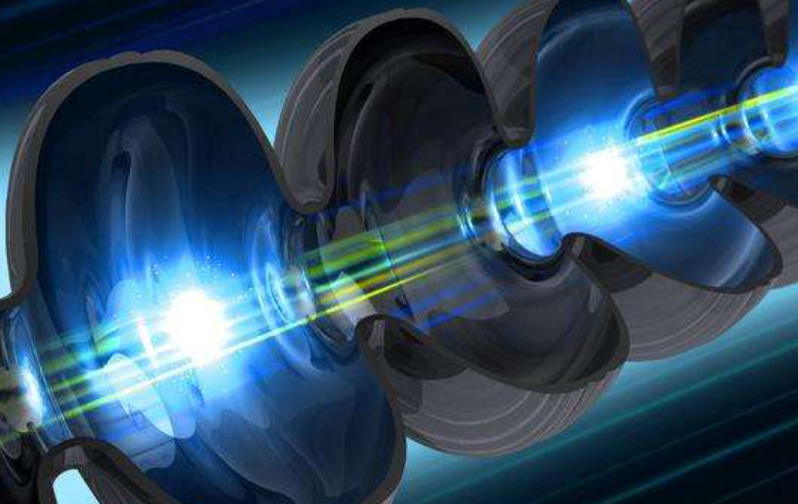
A femtosecond laser is an "ultrashort pulse light" generating device that emits light only for an ultrashort time of about one-gigasecond. Fei is the abbreviation of Femto, the prefix of the International System of Units, and 1 femtosecond = 1×10^-15 seconds. The so-called pulsed light emits light only for an instant. The light-emitting time of the flash of a camera is about 1 microsecond, so the ultra-short pulse light of femtosecond only emits light for about one billionth of its time. As we all know, the speed of light is 300,000 kilometers per second (7 and a half circles around the earth in 1 second) at an unparalleled speed, but in 1 femtosecond, even light only advances by 0.3 microns.
Often, with flash photography we are able to cut out the momentary state of a moving object. Likewise, if a femtosecond laser is flashed, it is possible to see every fragment of the chemical reaction even as it proceeds at a violent speed. To this end, femtosecond lasers can be used to study the mystery of chemical reactions.
General chemical reactions are carried out after passing through an intermediate state with high energy, the so-called "activated state". The existence of an activated state was theoretically predicted by chemist Arrhenius as early as 1889, but it cannot be directly observed because it exists for a very short time. But its existence was directly demonstrated by femtosecond lasers in the late 1980s, an example of how chemical reactions can be pinpointed with femtosecond lasers. For example, the cyclopentanone molecule is decomposed into carbon monoxide and 2 ethylene molecules by the activated state.
Femtosecond lasers are now also used in a wide range of fields such as physics, chemistry, life sciences, medicine, and engineering, especially in light and electronics. This is because the intensity of light can transmit a large amount of information from one place to another with almost no loss, further speeding up optical communication. In the field of nuclear physics, femtosecond lasers have brought a huge impact. Because pulsed light has a very strong electric field, it is possible to accelerate electrons to near the speed of light within 1 femtosecond, so it can be used as an "accelerator" for accelerating electrons.
Application in medicine
As mentioned above, in the femtosecond world even light is frozen so that it cannot travel very far, but even at this time scale, atoms, molecules in matter, and electrons inside computer chips are still moving in circuits. If the femtosecond pulse can be used to stop it instantaneously, study what happens. In addition to flashing time to stop, femtosecond lasers are able to drill tiny holes in metal as small as 200 nanometers (2/10,000th of a millimeter) in diameter. This means that the ultra-short pulsed light that is compressed and locked inside in a short period of time achieves an amazing effect of ultra-high output, and does not cause additional damage to the surrounding. Furthermore, the pulsed light of the femtosecond laser can take extremely fine stereoscopic images of objects. Stereoscopic imaging is very useful in medical diagnosis, thus opening up a new field of research called optical interference tomography. This is a stereoscopic image of living tissue and living cells taken with a femtosecond laser. For example, a very short pulse of light is aimed at the skin, the pulsed light is reflected off the surface of the skin, and a portion of the pulsed light is injected into the skin. The inside of the skin is composed of many layers, and the pulsed light entering the skin is bounced back as a small pulsed light, and the internal structure of the skin can be known from the echoes of these various pulsed light in the reflected light.
In addition, this technology has great utility in ophthalmology, capable of taking stereoscopic images of the retina deep in the eye. This allows doctors to diagnose whether there is a problem with their tissue. This type of examination is not limited to the eyes. If a laser is sent into the body with an optical fiber, it is possible to examine all tissues of various organs in the body, and it may even be possible to check whether it has become cancer in the future.
Implementing an ultra-precise clock
Scientists believe that if a femtosecond laser clock is made using visible light, it will be able to measure time more precisely than atomic clocks, and it will be the world's most accurate clock for years to come. If the clock is accurate, then the accuracy of the GPS (Global Positioning System) used for car navigation is also greatly improved.
Why can visible light make a precise clock? All clocks and clocks are inseparable from the movement of a pendulum and a gear, and through the oscillation of the pendulum with a precise vibration frequency, the gear rotates for seconds, and an accurate clock is no exception. Therefore, in order to make a more accurate clock, it is necessary to use a pendulum with a higher vibration frequency. Quartz clocks (clocks that oscillate with crystals instead of pendulums) are more accurate than pendulum clocks because the quartz resonator oscillates more times per second.
The cesium atomic clock, which is now the time standard, oscillates at a frequency of about 9.2 gigahertz (the prefix of the international unit giga, 1 giga = 10^9). The atomic clock uses the natural oscillation frequency of cesium atoms to replace the pendulum with microwaves with the same oscillation frequency, and its accuracy is only 1 second in tens of millions of years. In contrast, visible light has an oscillation frequency 100,000 to 1,000,000 times higher than that of microwaves, that is, using visible light energy to create a precision clock that is millions of times more accurate than atomic clocks. The world's most accurate clock using visible light has now been successfully built in the laboratory.
With the help of this precise clock, Einstein's theory of relativity can be verified. We put one of these precise clocks in the laboratory and the other in the downstairs office, considering what might happen, after an hour or two, the result was as predicted by Einstein's theory of relativity, due to the two There are different "gravitational fields" between the floors, the two clocks no longer point to the same time, and the clock downstairs runs slower than the one upstairs. With a more accurate clock, maybe even the time on the wrist and ankle would be different that day. We can simply experience the magic of relativity with the help of accurate clocks.
Light speed slowing technology
In 1999, Professor Rainer Howe of Hubbard University in the United States successfully decelerated light to 17 meters per second, a speed that a car can catch up with, and then successfully slowed down to a level that even a bicycle can catch up with. This experiment involves the most cutting-edge research in physics, and this article only introduces two keys to the success of the experiment. One is to build a "cloud" of sodium atoms at an extremely low temperature close to absolute zero (-273.15°C), a special gas state called Bose-Einstein condensate. The other is a laser that modulates the vibrational frequency (the laser for control) and irradiates a cloud of sodium atoms with it, and as a result, incredible things happen.
Scientists first use the control laser to compress the pulsed light in the cloud of atoms, and the speed is extremely slowed down. At this time, the control laser is turned off, the pulsed light disappears, and the information carried on the pulsed light is stored in the cloud of atoms. . Then it is irradiated with a control laser, the pulsed light is recovered, and it goes out of the cloud of atoms. So the originally compressed pulse is stretched again and the speed is restored. The entire process of entering pulsed light information into an atomic cloud is similar to reading, storing, and resetting in a computer, so this technology is helpful for the realization of quantum computers.
The world from "femtosecond" to "attosecond"
Femtoseconds are beyond our imagination. Now we're back in the world of attoseconds, which are shorter than femtoseconds. A is an abbreviation for the SI prefix atto. 1 attosecond = 1 × 10^-18 seconds = one thousandth of a femtosecond. Attosecond pulses cannot be made with visible light because shorter wavelengths of light must be used to shorten the pulse. For example, in the case of making pulses with red visible light, it is impossible to make pulses shorter than that wavelength. Visible light has a limit of around 2 femtoseconds, for which attosecond pulses use shorter wavelength x-rays or gamma rays. What will be discovered in the future using attosecond X-ray pulses is unclear. For example, the use of attosecond flashes to visualize biomolecules enables us to observe their activity on extremely short time scales, and perhaps pinpoint the structure of biomolecules.
Copyright @ 2020 Shenzhen Box Optronics Technology Co., Ltd. - China Fiber Optic Modules, Fiber Coupled Lasers Manufacturers, Laser Components Suppliers All Rights Reserved.